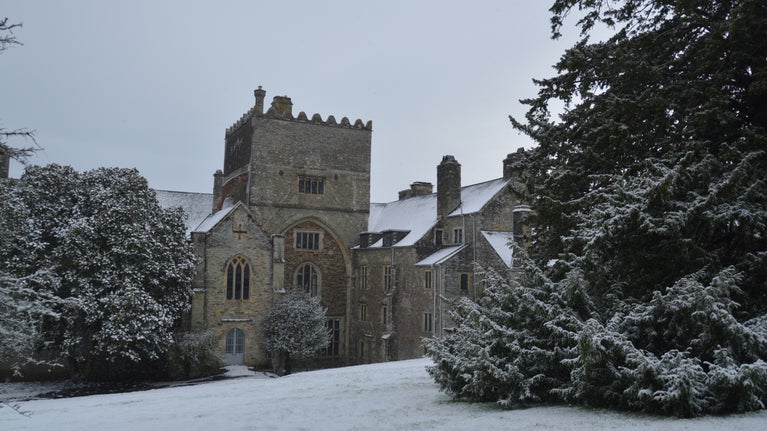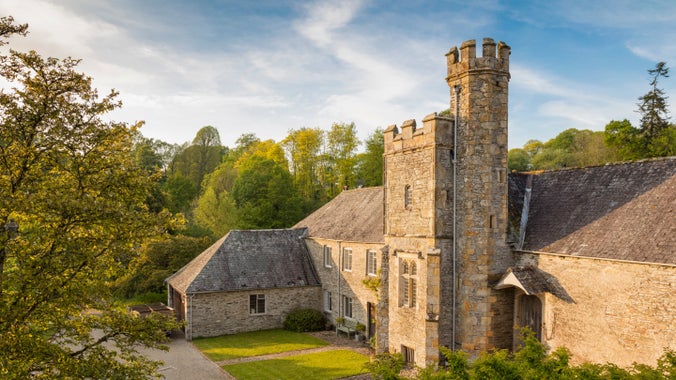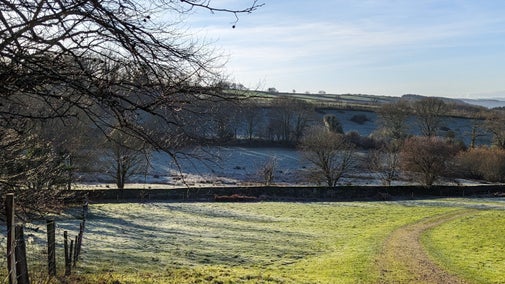
Discover more at Buckland Abbey
Find out when Buckland Abbey is open, how to get here, the things to see and do and more.

From Cistercian monastery to Tudor house, the history of Buckland Abbey is largely shaped by the memory and legacy of one man – Sir Francis Drake, the 16th-century Elizabethan hero, sea captain, privateer and slave trader. Set in an expansive estate in the Tamar Valley, the earlier monastic history of Buckland Abbey is most evident in the Great Barn, whilst the Abbey itself reflects generations of Drake’s descendants and the preservation of their ancestor’s memory.
Buckland Abbey was founded as a Cistercian monastery in 1278 by Amicia, Countess of Devon (c. 1220—84). The first monks came from Quarr Abbey on the Isle of Wight, Hampshire.
The Abbey was built in a single phase and the main building (though much altered), Great Barn, Abbot’s lodgings and Cider house remain today. The original complex would have been far larger, including cloisters, a bake house, workshops and an infirmary, set at the heart of an impressive 20,000 acre estate. Buckland was home to around twelve monks and an Abbot. Other local men were employed in various tasks, for example Robert Derkeham in 1522, who was a choirmaster and music teacher who lived on site.
This estate made the Abbey extremely wealthy. Monks worked as ploughmen, dairymen, shepherds, carpenters and masons. They also sold timber from the estate and benefited from local silver mining. The scale of the Great Barn gives a sense of this wealth; not only would wool, fleece, hides and crops be stored there, but also tithes (produce given as a form of tax) from local farmers.

Buckland Abbey’s time as a monastery ended at the Dissolution under the reign of Henry VIII. In 1539 Abbot John Toker and the remaining twelve monks were pensioned off. Richard Grenville (c. 1495—1550) acquired the lease to the Abbey in 1541 after which his son, Roger, moved there. Any plans to redevelop the Abbey were cut short when Roger died aboard the sunken Mary Rose in 1545.
It was Roger’s son, Richard Grenville (1542—91) who had the most dramatic and lasting impact on Buckland’s buildings, pulling down large parts of the Cistercian complex to make way for a grand, Tudor home. The cloisters were destroyed, as were the Abbey transepts. Building materials were either re-used or sold. Two floors were put directly through the main body of the Abbey’s nave. At its centre, the new Great Hall still retains the plasterwork and overmantel dating the completion of this work to 1576.
Like his seafaring father, and cousins Sir Walter Raleigh and Humphrey Gilbert, Richard was drawn to the sea. Buckland’s prime location on the river Tavy, close to Plymouth, suited his privateering voyages. He undertook many early and exploratory voyages with the aim of colonising lands in North America, including a failed attempt to establish a colony at Roanoke, a territory belonging to Alonquian-speaking people.
Though he only lived there for 15 years, Buckland Abbey is synonymous with its most famous owner, Sir Francis Drake (1540—96) – Elizabethan hero, sea captain, privateer and slave trader. Fresh from his circumnavigation of the globe and newly knighted by Queen Elizabeth I, Francis acquired Buckland in 1581.
During his time there, Francis became Mayor of Plymouth and is remembered for supplying fresh water from Burrator on Dartmoor to Plymouth. He married Elizabeth Sydenham in 1585 and it is likely that she spent the most time at Buckland. Francis was rarely at home and went away to sea for large parts of 1584—87 on royally sanctioned raids in the Caribbean, attacking Spanish ports and ships to destroy Spanish strongholds, stealing their goods and also capturing people - some of whom were enslaved, while others were held as prisoners.
In 1588, Drake was made second in command to Lord Howard as they fought against and defeated the Spanish Armada in the English Channel. Drake’s last voyage was in 1595—96 when a fever broke out aboard his ship and he died of dysentery. He had no children, so the ownership of Buckland Abbey passed to his brother, Thomas.
Buckland Abbey remained in the ownership of the Drake family until the 20th century. Every generation was highly aware of their famous ancestor and preserved and enhanced many elements of the Abbey to reflect his achievements.
A number of objects associated with Drake were preserved and became known as the ‘Drake relics’. Many remained on public display at Buckland until the 20th century and included Drake’s Drum and a silver-gilt cup said to have been given by Elizabeth I, both now on display at The Box, Plymouth. A set of six banners or flags remain at Buckland today. Two of these are painted royal standards bearing Elizabeth I’s arms. Legend has it that they are mementoes from April 1581, when the Queen knighted Francis on board his ship the Golden Hinde.

The story of Buckland Abbey in the 18th and 19th centuries is one of investment and neglect. In 1732, then owner Sir Francis Henry Drake, 4th Baronet (1694—1740) inherited Nutwell Court near Lympstone, and made it the Drake family’s main residence. Letters from Buckland’s estate steward, Nicholas Rowe, reveal challenges with a leaky roof and water ingress. Investment was still made in the gardens, with increased tree planting and the management of a herd of deer.
Sir Francis’ son, the 5th Baronet, also Sir Francis Henry Drake (1723—94), started to address the challenge that a leaky Buckland was quickly becoming. From 1769 he invested in repair and renovation including the installation of the staircase and dining room paneling, and the remodelling of the kitchens as they are seen today.
Francis also sought advice on the wider estate, consulting agricultural improver, William Marshall (1745—1818) whose book Rural Economy of the West of England, 1796 was dedicated to Francis. Marshall made recommendations for Buckland covering the care of the soil, management of crops, livestock, woodlands and orchards as well as water supply, irrigation, the river and its fishery and the adaptation or removal of existing farm buildings.
When the 5th Baronet died without children, Buckland passed to his nephew, General Francis Augustus Eliott, 2nd Baron Heathfield (1750—1813) who continued the renovation work. As well as significant landscaping in the grounds, in 1801 he appointed the architect Samuel Pepys Cockerell (1753—1827) to design improvements for both Buckland and Nutwell court.
Cockerell was best known for his Mughal-Indian inspired house at Sezincote for his brother Sir Charles Cockerell and later became Surveyor for the East India company. At Buckland, Cockerell’s staircase tower and a crenelated north porch were built but his design for an entrance lodge to also serve as a ‘sea mark’ was never executed.
Many years of investment were brought to an end when Heathfield died in 1813 and the estate was tenanted out for the rest of the century.

The last tenant left Buckland in 1899, and a few years later, Elizabeth Drake (1840—1923) and Sir Francis Fuller-Eliott-Drake (1837—1916), retired there. Elizabeth was often the face of the family at civic events, for example, attending the unveiling of the statue of Sir Francis Drake on Plymouth Hoe. She demonstrated a strong interest in her family history, publishing The Family and Heirs of Sir Francis Drake in 1911 based on available family archives.
Her daughter, Elizabeth Beatrice Fuller-Elliott Drake (1862—1937), was the last to live at Buckland and continued to maintain and promote her important family history. She retained the Drake ‘relics’ on display in the Great Hall and her portrait – where she wears the famous Drake Jewel and stands in front of an Armada tapestry - demonstrates a proud declaration of this ancestry. Her main impact on the building was the creation of a Roman Catholic chapel in the former servants’ hall in 1917.
Financial problems in the first half of the 20th century and a major fire left Buckland in a sorry state. The estate was broken up and sold off in 1946. The Abbey and its surrounding gardens were purchased by Captain Arthur Rodd and presented to the National Trust. A local campaign, spearheaded by the American-born British politician Lady Astor, claimed that it was a ‘National responsibility,’ to save Buckland as ‘an important symbol of our heritage, the home of one of Plymouth’s famous sons, Sir Francis Drake.’
The Abbey was leased to Plymouth City Council and, with a grant from the Pilgrim Trust, restored and opened to the public in 1951 to coincide with the Festival of Britain. As Buckland was acquired without any collections, the City Council displayed items from their permanent collection, including items once belonging to Drake. The National Trust took Buckland Abbey fully under its care in 1988 and redisplayed the Abbey retaining some of the loans.
Over the years, the National Trust has acquired a number of star collections including the 16th and 17th century Drake banners, and a self-portrait by Rembrandt. Additional purchases of remaining estate land (1980s) and the Cider House and Tower Cottage (2011) also reunited parts of the historic estate.
Davey, James., (2018) Tudor and Stuart Seafarers: The Emergence of a Maritime Nation, 1485-1707. National Maritime Museum, Greenwich
Kelsey, Harry., (2009) Drake, Sir Francis (1540-1596) Oxford Dictionary of National Biography
Loades, David., (2008), Grenville, Sir Richard Oxford Dictionary of National Biography. Grenville, Sir Richard (1542–1591), naval commander | Oxford Dictionary of National Biography (oxforddnb.com)
Wathen, B., (2001) Making Drake. The Cultural Construction of Sir Francis Drake from the Late Sixteenth Century to the Present. Unpublished PhD Thesis. University of Exeter.

Find out when Buckland Abbey is open, how to get here, the things to see and do and more.
See the painting at Buckland Abbey which was revealed as a genuine self-portrait by the famous Dutch artist Rembrandt.

Explore the abbey which is part museum, part house, and filled with treasures. Step inside the medieval Great Barn: a tithe barn unchanged since it was built centuries ago.

Discover Buckland's ancient woodland on one of three colour coded routes. With abundant wildlife and far reaching views, it's a peaceful and fascinating place to enjoy.

Take a break at the Ox Yard coffee shop, which serves tea, coffee, light lunches and sweet treats, before finding a special gift or souvenir in the National Trust shop, art galleries and second-hand bookshop.

Buckland Abbey is a two pawprint rated place. There are plenty of dog-friendly walks through the woodland and countryside to explore and dogs are welcome to relax in the Ox Yard coffee shop.

Learn about people from the past, discover remarkable works of art and brush up on your knowledge of architecture and gardens.

Explore the objects and works of art we care for at Buckland Abbey on the National Trust Collections website.

From beautiful blooms to bountiful harvests, the gardens at Buckland Abbey are full of colour and seasonal interest. Soak up the history of this special place as you admire the planting, or simply enjoy the peace and tranquillity as you sit a while on one of the benches.
